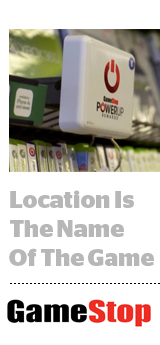 GameStop isn’t playing around when it comes to omnichannel, and here’s why.
GameStop isn’t playing around when it comes to omnichannel, and here’s why.
Roughly 60% of GameStop’s customers first engage with the video game retailer online. Of that number, 26% show up at one of its more than 6,600 brick-and-mortar stores within 48 hours and make a purchase. About 40% of its traffic comes from mobile.
“The key objective is to equalize channels,” said Jeff Donaldson, current SVP and former CIO of the Texas-based GameStop Technology Institute (GTI), speaking at the Place conference in NYC on Tuesday.
Formed in March 2014, GTI is GameStop’s internal tech innovation lab that’s tasked with digitizing the store experience and creating a balance between physical locations and digital and mobile commerce platforms.
While online retailers can get a fairly granular picture of customer interaction – whether users have abandoned their cart, which product pages they visit most frequently, average order value, churn – brick-and-mortar needs to get a little more creative and a lot more integrated.
That’s where location tech and mobile enter the physical scene – and in Donaldson’s mind, there shouldn’t be a dividing line in the way brands think about those channels.
“Our customers go into our stores to buy content; they go online to buy content,” he said. “Mobile is a fast-growing, productive digital engagement channel for our customers … [and] it’s a great place to deliver new experiences.”
GTI was in full-scale experimentation mode throughout Q2, using 36 of its store locations around Austin as a testing ground for geofencing, beacons, in-store mobile messaging and augmented reality.
GameStop limited its testing to members of PowerUp, the brand’s 40-million-strong loyalty program. More than 28 million of those users are US-based. According to Donaldson, 71% of GameStop’s video game sales come from PowerUp members, which make up three times more sales and five times the amount of profitability when compared with consumers who aren’t members of the loyalty program.But customers who have also downloaded the GameStop app, which has more than 4 million downloads, are even more valuable still, spending 81% more than the average PowerUp user, said Mike Hogan, GameStop’s EVP of strategic business, during a recent company earnings call.
Upon walking into a store, PowerUp users who have also downloaded the GameStop app are greeted with a customized push message containing discount info, as well as promotions related to their personal interests or items on their wish list. The customer’s presence is also automatically registered on tablets carried around by store associates.
Beacons by Microsoft and Shelfbucks-powered Qualcomm are strategically placed throughout the store and beam out product information, game overviews and video game trailers, and an augmented reality feature allows customers to hold up their phones to a video game box to watch videos and view related content.
GameStop is planning to bring these and other related experiences beyond its central Texas test markets to stores in New York, the San Francisco Bay Area and Nashville next month, followed by a nationwide rollout.
While GTI saw good results during the test – when consumers were given the opportunity to digitally engage within a store, for example, their conversion rates on single items improved, as did the likelihood that they’d buy multiple products – location technology is still a work in progress for GameStop.
Take geofencing. Although GameStop has found it to be extremely handy in terms of analytics and detecting a customer’s in-store presence, Donaldson admits that GTI has not yet “cracked the code” on when and how to take advantage of those insights, especially around mobile messaging.
Brand need and UX aren’t always aligned.
“Our customer feedback is that it’s a little spammy and it’s a little creepy,” he said,“particularly when we test messaging that’s associated with a competitor.”














